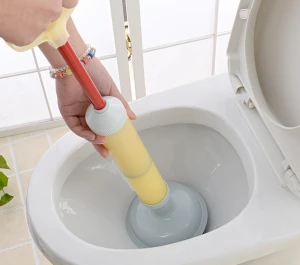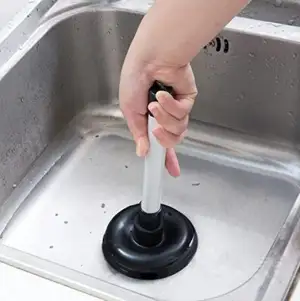Tips to Master Plungers and Drain Cleaners: Specialist Advice
Tips to Master Plungers and Drain Cleaners: Specialist Advice
Blog Article
Any individual will have their private perception when it comes to Here's How to Correctly Use a Toilet Plunger.

Introduction
Correct maintenance of household drains is vital for stopping blockages and making certain smooth water circulation. Among the secret devices in every property owner's toolkit is the plunger, together with numerous drain cleaners developed to tackle stubborn obstructions effectively. This short article explores exactly how to make use of plungers and drainpipe cleaners properly to maintain your drains moving openly.
Section 1: Recognizing Plungers
Kinds of Plungers
There are numerous kinds of plungers offered, each developed for various kinds of drains pipes and clogs. The most common types consist of cup plungers, flange plungers, and accordion bettors.
How Plungers Job
Bettors deal with the concept of creating stress and suction to dislodge clogs. When correctly applied over a drainpipe, they create a vacuum that can pull out debris or separate clogs.
Picking the Right Plunger
Choosing the ideal plunger relies on the kind of drainpipe and the nature of the blockage. Cup plungers are excellent for sinks and tubs, while flange plungers are much better matched for commodes due to their style.
Common Mistakes with Bettors
Preventing these errors guarantees effective plunging: improper seal around the drain, insufficient pressure, and unclear surrounding particles.
Section 2: Using Plungers Properly
Prep work
Prior to diving, ensure the bettor covers the drainpipe entirely and develops a limited seal. Clear any kind of noticeable particles around the drainpipe opening.
Strategy
Beginning with mild diving movements to construct suction. Boost pressure slowly, using a stable rhythm. Repeat as required until the drainpipe removes.
Troubleshooting Tips
If diving doesn't work, attempt adjusting the seal, using petroleum jelly for a better seal, or making use of a different sort of bettor.
Section 3: Understanding Drain Cleaners
Kinds Of Drain Cleaners
Drain cleaners can be chemical or chemical. Chemical cleaners utilize solid chemicals to liquify blockages, while chemical cleaners use all-natural enzymes to break down raw material.
Exactly How Drain Cleansers Job
Chemical cleansers react with blockages to liquify them, while enzymatic cleaners break down organic materials like hair and grease without hurting pipes.
Safety and security Considerations
Constantly put on gloves and eye defense when using chemical drainpipe cleaners. Guarantee sufficient air flow and comply with producer guidelines meticulously.
Eco-Friendly Alternatives
Take into consideration using vinegar and baking soda or enzyme-based cleaners for green alternatives that are more secure for pipelines and the setting.
Area 4: Utilizing Drain Cleaners Successfully
Application Techniques
Pour chemical cleaners directly into the drainpipe opening. Permit them to help the suggested time before purging with hot water. Enzymatic cleansers ought to sit over night.
Safety measures
Prevent mixing various kinds of cleaners, as this can generate hazardous fumes. Never ever utilize chemical cleaners in conjunction with a plunger, as spilling can happen.
Taking Care Of Stubborn Clogs
For relentless obstructions, consider utilizing a pipes serpent or calling a professional plumbing technician to avoid damage to pipelines.
Verdict
To conclude, comprehending how to make use of bettors and drain cleaners successfully is crucial for keeping healthy pipes systems. By picking the right tools and techniques, home owners can deal with small obstructions and prevent significant plumbing problems down the line.
How to Use a Plunger to Unclog a Drain
The humble plunger is a simple yet effective tool for breaking clogs in sinks, tubs and toilets. This handy tool is easy to use. You can make the most of its power if you understand how it works. Ready to dive in? Here’s what you need to know.
Safety First!
Never use a plunger with drain chemicals. Water will splash as you work, and the chemicals can spatter, burning skin and eyes. It’s a good idea to use rubber gloves and wear safety goggles when you work on a clog.
Choose the Right Tool for the Job
Plungers come in two different styles. Sinks, bathtubs and showers require a cup plunger. Like its name suggests, the rubber end is shaped like a cup. Use a flange plunger on toilets. These plungers have a rubber funnel extending from the cup. A plunger needs to be big enough to cover the drain.
Ready, Set, Plunge!
Coat the rim: Coat the plunger rim with petroleum jelly. This helps make a better seal.
Block outlets: Hold a wet rag over nearby outlets such as the overflow vent or the drain in a second sink.
Release air: Insert the plunger at an angle into the water. Water will displace air in the cup. A water-filled cup is more forceful than one filled with air.
Keep the plunger upright: Hold the plunger perpendicular to the drain. Use fast, forceful strokes, but make the first stroke gentle. The first stroke can create a splash if the cup still contains air. Thrust the plunger 15 to 20 times.
Snap off the plunger: The final stroke should be a strong upward motion that ends when the plunger snaps off the drain.
Repeat the process: you may need to repeat this sequence several times. When the water drains away, your work is done. High-five! https://plumbernw.com/blog/how-to-use-a-plunger-to-unclog-a-drain/

Application Techniques
Pour chemical cleaners directly into the drainpipe opening. Permit them to help the suggested time before purging with hot water. Enzymatic cleansers ought to sit over night.
Safety measures
Prevent mixing various kinds of cleaners, as this can generate hazardous fumes. Never ever utilize chemical cleaners in conjunction with a plunger, as spilling can happen.
Taking Care Of Stubborn Clogs
For relentless obstructions, consider utilizing a pipes serpent or calling a professional plumbing technician to avoid damage to pipelines.
Verdict
To conclude, comprehending how to make use of bettors and drain cleaners successfully is crucial for keeping healthy pipes systems. By picking the right tools and techniques, home owners can deal with small obstructions and prevent significant plumbing problems down the line.
How to Use a Plunger to Unclog a Drain
The humble plunger is a simple yet effective tool for breaking clogs in sinks, tubs and toilets. This handy tool is easy to use. You can make the most of its power if you understand how it works. Ready to dive in? Here’s what you need to know.
Safety First!
Never use a plunger with drain chemicals. Water will splash as you work, and the chemicals can spatter, burning skin and eyes. It’s a good idea to use rubber gloves and wear safety goggles when you work on a clog.
Choose the Right Tool for the Job
Plungers come in two different styles. Sinks, bathtubs and showers require a cup plunger. Like its name suggests, the rubber end is shaped like a cup. Use a flange plunger on toilets. These plungers have a rubber funnel extending from the cup. A plunger needs to be big enough to cover the drain.
Ready, Set, Plunge!
Coat the rim: Coat the plunger rim with petroleum jelly. This helps make a better seal. Block outlets: Hold a wet rag over nearby outlets such as the overflow vent or the drain in a second sink. Release air: Insert the plunger at an angle into the water. Water will displace air in the cup. A water-filled cup is more forceful than one filled with air. Keep the plunger upright: Hold the plunger perpendicular to the drain. Use fast, forceful strokes, but make the first stroke gentle. The first stroke can create a splash if the cup still contains air. Thrust the plunger 15 to 20 times. Snap off the plunger: The final stroke should be a strong upward motion that ends when the plunger snaps off the drain. Repeat the process: you may need to repeat this sequence several times. When the water drains away, your work is done. High-five! https://plumbernw.com/blog/how-to-use-a-plunger-to-unclog-a-drain/

I recently found that blog entry about while browsing on the internet. If you please take the time to promote this content if you liked it. I truly appreciate reading our article about How to Use a Plunger to Unclog a Toilet or Drain.
Click Here To Read More Report this page